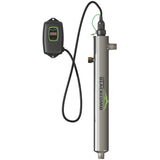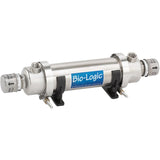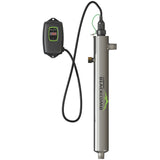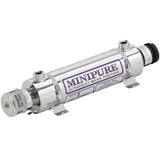UV Water Purification Makes Sense for Aquariums and Ponds
Posted by Nick on for ProLampSales

One unpleasant discovery that many homeowners and aquarium hobbyists make is that their ponds or aquariums can quickly become a haven to aggressive algae and harmful pathogens that kill fish and plants. Cloudy water, sick marine life, and an overall unhealthy look and feel to the water are the result.
But growth of algae is a common, natural occurrence, resulting from feeding, filtration of biological materials, and fish/plant activities in the water. Also, light exposure will also encourage algae growth, and light is essential to the health of any body of water.
This means that all aquariums and ponds are susceptible to parasites, bacteria, and algae growth. And because of the small size of many microorganisms, problems are difficult to detect until it's too late. By the time parasites and bacteria are detected, they are already causing problems to fish and plants.
If the problem already exists, reactive strategies can clean the pond or aquarium and treat the fish. Cleaning, water filter maintenance, and quarantine of sick fish can all help after the fact.
How UV Keeps Ponds & Aquariums Healthier and Cleaner
Installing an ultraviolet water purifier is an effective strategy for preventive maintenance of ponds and aquariums. These systems use UV-C light bulbs, which emit a wavelength of light (254nm) that is lethal to bacteria, viruses, mold, and fungi, and can be installed in various configurations.
UV-C lights can be installed in-line and treat from one to hundreds of gallons per minute, depending on the size, flow rate, and power of the ultraviolet germicidal light bulb. They should be placed after the biological or mechanical filtration system, and flow rate of the water should be controlled.
In general, a lower flow rate is appropriate for aquariums and fish tanks, while a higher flow rate is recommended for outdoor ponds. Some UV water purifiers can be configured with different flow control valves, while others have a set flow rate out of the box.
UV light treatment of the water can not save fish that are already sick, but they can prevent the disease from spreading further. For inhabitants that are already sick, quarantine or medication to combat the disease are recommended.
And for the fish, plants, and beneficial bacteria in the aquarium or pond, an ultraviolet sterilizer system is safe. Beneficial bacteria living on rocks, gravel, wood, and other materials will not be exposed to the UV-C light, so will survive.
Installing a UV water purifier should be considered as an extra layer of defense for any aquarium or outdoor Koi pond. They can be installed in freshwater or marine fish tanks and almost any type of pond.
As the water is treated by the ultraviolet germicidal light, harmful pathogens are deactivated, making the water healthier. One side benefit is that this can make the water clearer over time.
Maintenance Tips for Pond/Aquarium UV Systems
Maintenance of a UV water system should also be considered, as they need routine maintenance and cleaning. This should be taken into account even before installing the water purifier, to make it convenient to clean the purifier or replace parts.
While UVC water purifiers require little maintenance and are fairly simple, replacing the UV light bulb and quartz sleeve should be done every year. Many UV bulbs are rated for around 10,000 hours of continuous use, which comes out to a little over one year. However, UV output can diminish over time, and the bulb may become less effective at killing germs. Replacing the UV bulb once a year at the same time the visible light aquarium bulbs are replaced is an effective maintenance schedule.
UV water purifiers also utilize a quartz sleeve to keep the bulb from getting wet. Quartz transmits the wavelength effective for deactivating pathogens, while protecting the bulb. These sleeves should also be replaced on a regular basis, and inspected often. They can be cleaned off if debris or a film has attached to the sleeve.
- Posted in Aquarium, Ultraviolet Light
Featured Products (View All)
0 Comments




